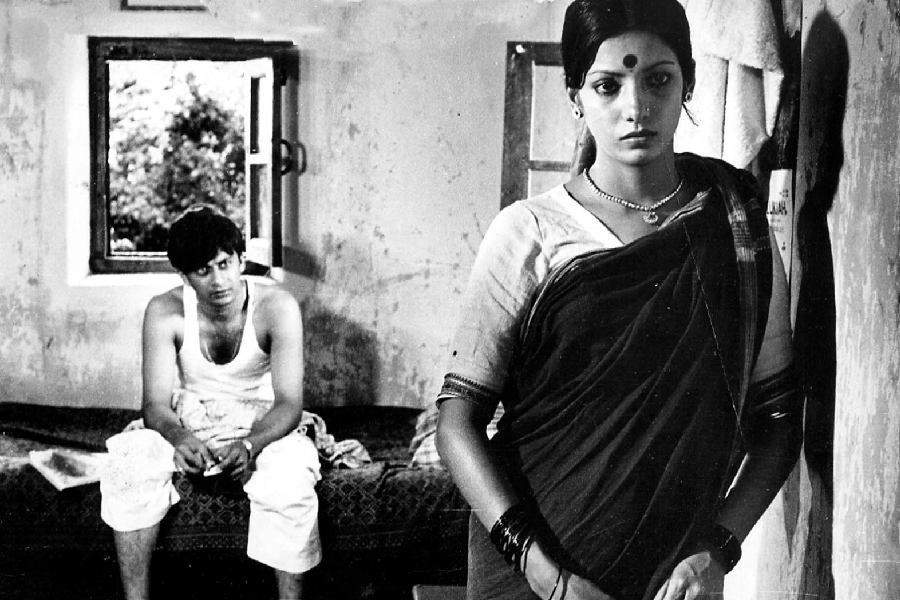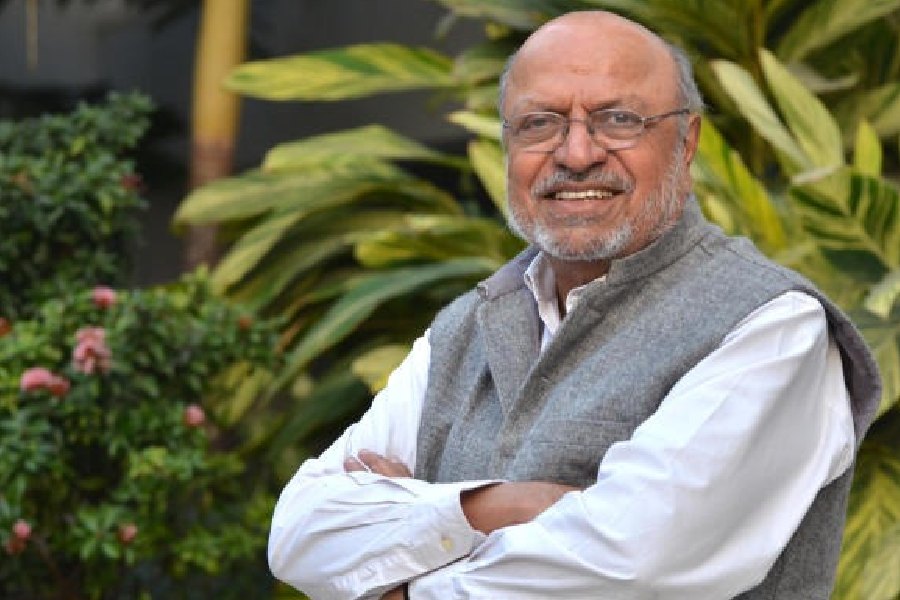In the 1980s, the era in which I started watching films in earnest, catharsis took all of three hours. The films of Amitabh Bachchan, and others in mainstream Hindi cinema, offered retribution for all injustices inflicted on the protagonist through bombastic dialogues, gratuitous fights and a neatly sewn-up climax where all conflicts were resolved and everyone walked into their happily-ever-after sunsets. And all was right with the world as the lights came on and we left the hall.
Which is why this particular climactic sequence left me conflicted. I could not get over the feeling that there lingered a sense of something left incomplete, something more to come, in Ankur. As Surya (Anant Nag) whips Kishtaya (Sadhu Meher) mercilessly, Lakshmi (Shabana Azmi) comes to the latter’s rescue. For a couple of electrifying minutes, Lakshmi rants and curses Surya in what is one of Indian cinema’s finest moments. As she walks off with Kishtaya, to the mournful strains of a flute and a sarod in the background, the camera moves to a young boy in shorts. The soundtrack goes silent. The boy picks up a stone and pelts it at a window of Surya’s house. As he runs away, the soundtrack comes alive with the clamour of birds in the forest. The screen fades to red.
That’s it.
I had around the time watched Amitabh Bachchan’s Vijay swaying almost drunkenly to a water tap after the warehouse fight sequence in Deewaar, his shirt tied in a knot, as he dunks his head under the water gushing from the tap. The audience in the theatres had erupted. I was thrilled to see him getting the better of a goon in Kaala Pathar, just staring unblinkingly at him, even as the audience whistled and clapped.
In contrast, as the screen faded to red in Ankur, I found myself sitting in Shakuntalam theatre for a few minutes, not sure how to respond. This was as dramatic, as explosive a sequence as the Amitabh Bachchan ones that made me want to take on the world. It should have been as cathartic. However, I could not bring myself to clap. I could not revel in the underdog giving the oppressor a warning of the time to come. And in any case, the time to come was represented by only a fade to red.
Years later, when I met the director, I wanted to tell him about this. About the realisation of a new kind of aesthetic that Ankur introduced me to. I wanted to ask him about it. I could never, though I met him a few times over the next decades. Maybe I was too scared of the enormity of interviewing an artist of his stature. What could I ask that would not sound foolish? Maybe I wanted to nurture within me the sentiments that sequence evoked without looking for explanations. It has remained as raw and immediate as at that first screening. I still loved the three-hour purging that Bachchan offered. But somewhere, Ankur opened my mind to what the real deal was.

Shabana Azmi and Anant Nag in Ankur TT archives
A whole new way of making cinema
Ankur was of course a pioneering film. And suitably named. It was the seedling from which sprouted a whole new way of making cinema, of looking at cinema, of trying to understand cinema. If as Adoor Gopalakrishnan said about Satyajit Ray, ‘Indian cinema could be divided into two eras – before and after Ray’, one could say the same thing about Shyam Benegal and his influence on Hindi cinema.
Over the next 10 years, Shyam Benegal’s oeuvre boasted a roster of films that is impossible to imagine coming from one director – Nishant, Manthan, Bhumika, Junoon, Mandi and Trikaal, to name just a few. Even when a film did not come together fully, like, say, Kalyug, it was miles ahead of what many other, more commercially successful directors were churning out. Even though the revolution hinted at in the fade-to-red did not come to fruition in real life, and even though by the mid-1980s, Benegal’s brand of cinema was gasping for breath, there is no doubt that Ankur revolutionised Hindi cinema.
So much has been written about the man and his films – the repertoire he fostered, the talents he nurtured (among them Govind Nihalani, Shama Zaidi and Vanraj Bhatia). In fact, in Vanraj Bhatia, we have one of the icons of the era when it comes to music and Benegal’s contribution to film music of the era has not received the attention it deserves. I would like to limit my tribute to my few exchanges with him.
What I found fascinating about the man was his approachability. I met him for the first time during my stint in Bombay, 1998-2001. I was studying at the Xavier’s Institute of Mass Communication, and was conceptualising a magazine on cinema. I had worked out an arrangement with Sight and Sound magazine of the British Film Institute whereby 50 per cent of the content would be provided by them. The rest, I would curate on my own, on Indian cinema, on advertisement films.
I approached Mr Benegal. He not only asked me to meet him but discussed the magazine in detail. In fact, at the first meeting he asked me, ‘So you want to do what Cahiers and its critics and filmmakers did?’ I was speechless. I had only a fleeting idea of Cahiers and its impact at the time and for me even having this conversation was beyond my wildest imagination. Eventually, he agreed to come on board as chief advisor of the then one-member editorial team. At the end of the meeting, I asked him if I could do a long interview with him on his work. He agreed.
Over the next year, my teacher at XIC, Anil Zankar, and I brought out six very well-received issues of Lights Camera Action (filmmakers like Anurag Kashyap became patrons of the magazine). Mr Benegal would call me every time an issue came out and we would meet to discuss. I also prepared and gave him a long list of questions for the interview. Eventually, like all good meaningful magazines, Lights Camera Action folded up. Mr Benegal was in the middle of preparing for his Bose film at the time and the interview never happened.
A filmmaker who makes you go back to his films time and again
The next time I met Mr Benegal was sometime in 2005. I had written a book of essays on 15 icons of the Hindi film industry for Penguin Books, and had approached him for a foreword. He wanted to read the text. I couriered a printout to him.
He called back, and asked, the laughter in his voice palpable, ‘You don’t see me as an icon?’ He was not among the 15 legends I had documented in the book. I could only sheepishly mumble, ‘I don’t see you as Bollywood’ (the book was titled Icons from Bollywood). He was gracious enough to give me a glowing foreword. I met him with a copy of the book when it was published. I still remember what he said: ‘It is heartening that such lucid writing on mainstream cinema is being attempted and published.’
Writing on Hindi cinema was not yet the beast it has become in the past decade or so, and barring Anupama Chopra’s Sholay, and a couple of others, books on mainstream Hindi cinema were few and far between. Interestingly, Icons from Bollywood was published by Penguin’s children imprint, a sign that Bollywood was catching on. At the end of the meeting, he said, a twinkle in his eye, ‘We have not yet got down to the interview.’ He was busy at the time and I had a job to get back to and the interview remained on the backburner.
I met him a couple more times after that – once at the launch of Sangeeta Dutta’s book on him, at a function at the British Council in Delhi. And the next at the Satyajit Ray Memorial Lecture in 2012. As editor at HarperCollins Publishers, I had just published what was the first of a series of books on Ray in association with the Satyajit Ray Society. The Society had invited him to deliver the lecture and it remains one of the best lectures of the series. This time I brought up the matter of the interview and he guffawed. He had a flight to catch soon after and the interview did not happen.
Earlier this year, on the occasion of the Film Heritage Foundation restoration of Manthan and its screening, I was privileged to meet him again. He wasn’t keeping very well and my conversation with him focused primarily on Manthan. His enthusiasm was like a child’s as he preened over what Shivendra Dungarpur had managed with the restoration. As he and his long-time collaborator and legendary cinematographer Govind Nihalani never tired of underlining – the restored version looked better than the original did. It was the experience of a lifetime to watch the film in the theatre with a number of members of the cast and crew, including Mr Benegal and Mr Nihalani, Naseeruddin Shah, Preeti Sagar (the voice behind some of the immortal songs in Benegal’s films) and Kulbhushan Kharbanda.
It was at this meeting that I clicked my first photograph with him. All earlier occasions happened much before I had a camera phone. It was at this meeting that I also got to present him a copy of the book I had published a few months ago: The Swinging Seventies. The book includes two evocative essays on him, one by Amitava Kumar and the other by Aseem Chhabra. He leafed through the book. A long time had passed since our last meeting, he was in frail health, and his memory wasn’t as sharp. As he settled on the book’s cover, the name must have rung a bell. He looked up at me and said, ‘You are that Shantanu…’
We did not bring up the interview we never managed to do. In many ways I am glad about that. That sequence in Ankur and the emotions that it aroused in me that afternoon 40 years ago are special maybe because I have not been able to fathom, or put in words, what it meant. My understanding of that sequence remains incomplete, and that is what makes me want to go back to it and to his other films time and again. How many films, how many filmmakers offer that? It is only fair then that my interview with Shyam Benegal remained undone. In this incompleteness lies the essence of my relationship with this great director and human being.











